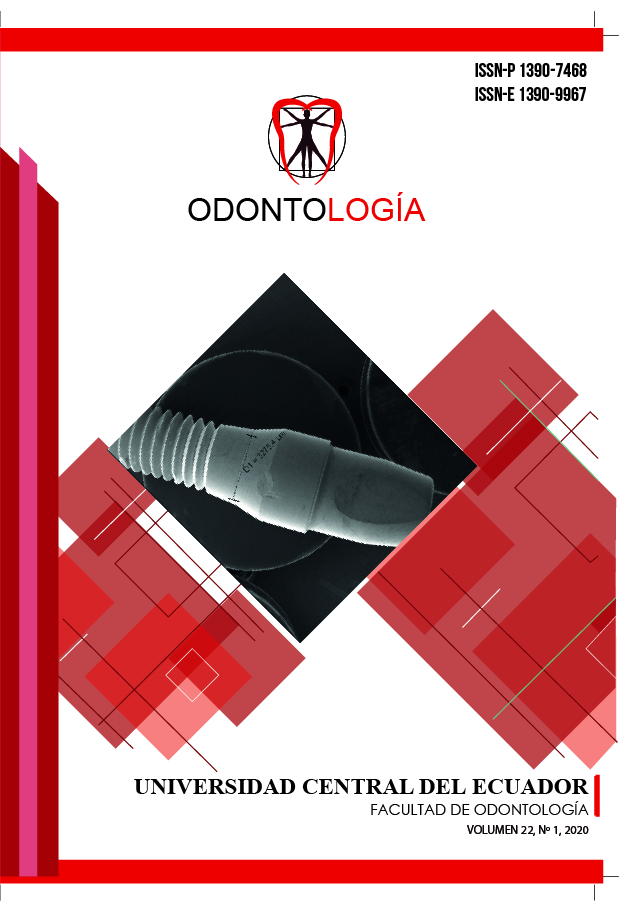Adaptation of straight pillars on implants with internal and external hexagonal connection by scanning electronic microscopy
DOI:
https://doi.org/10.29166/odontologia.vol22.n1.2020-21-35Keywords:
Dental implants, dental implant - abutment design, prosthesis fitting, rostheses and implants, dental leakageAbstract
In oral implantology, the implant-pillar interface has been a subject of research and constant evolution, mainly from the biomechanical and biological point of view. Objective: To assess the gap in the implant-abutment interface in internal and external hexagonal connection implants by means of scanning electron microscopy (SEM). Materials and Methods: In vitro study in 24 implants (Bionnovation®) divided into two groups (n = 12): internal and external hexagonal connection. For the experiment, straight pillars with 30N of torque were screwed. In turn, 6 implants per group underwent 500,000 cycles of dynamic loading; Subsequently, the space of the pillar implant interface at 3 points of all samples was evaluated by MEB, the means of the results of each specimen were supported in Excel tables and analyzed in the BioEstat 5.3 program. Results: Using a T test for independent samples, with a significance of 95%, a very significant difference was found after the application of the dynamic load in the external hexagon implants (p = 0.0002). In the internal hexagon implants there was also a statistical difference (p = 0.03). Between the external and internal hexagon implants there were very significant differences in the accuracy of the adjustment in the abutment implant interface before and after the application of the dynamic loads (p = <0.0001 and p = 0.0003 respectively). Conclusions: Dynamic loads significantly increased the discrepancy in the implant-abutment connection of the external and internal hexagon implants (p = <0.05); additionally, the gap distance was greater for external hexagon implants in contrast to Internal Hexagon implants before and after dynamic loading, being very significant (p = <0.0003).
Downloads
References
Jansen V, Conrads G, Richter E. Microbial leakage and marginal fit of the implant-abutment interface. Int . J Oral Maxillofac Implants. 1997; 12: p. 527-540.
Byrne D, Houston F, Cleary R, Claffey N. The fit of cast and premachined implant abutments.. J Prosthet Dent. 1998; 80: p. 184-192..
Al-Turki L, Chai J, Lautenschlager E, Hutten M. Changes in prosthetic screw stability because of misfit of implant-supported prostheses. Int. J Prosthodont. 2002; 25: p. 38-42..
Pérez Jiménez C. Evaluacion in vitro de la precisión de ajuste de pilares sobre implantes con conexión hexagonal interna y externa. In Trabajo de investigación Máster en Ciencias Odontológicas. MADRID: Facultad de Odontología Universidad Complutense de Madrid ; 2013.
Cibirka RM NSLBRF. Examination of the implant-abutment interface after fadigue testing. J Prosthet Dent. (2001) ; 85(3):268–275.
Costa Alves D, Perri de Carvalho P, Elias C, Vedovatto E, Ferreira Martinez E. In vitro analysis of the microbiological sealing of tapered implants after mechanical cycling. Clin Oral Invest. 2016.
Santos A. Biomechanical study of prosthetic interfaces: A literature review.. Dental Press Implantol. 2013 Oct-Dec;7(4):90-7. .
Gil F, Aparicio C, Manero J, Padros A. Influence of the height of the external hexagon and surface treatment on fatigue life of commercially pure titanium dental implants.. Int J Oral Maxillofac Implants. 2009 Jul-Aug;24(4):583-90. .
Dias E, Bisognin E, Harari N, Machado S, da Silva C, Soares G, et al. Evaluation of implant-abutment microgap and bacterial leakage in five external-hex implant systems: an in vitro. Int J Oral Maxillofac Implants. 2012 Mar-Apr; 27 (2): 346-51.
Tsuge T, Hagiwara Y. Influence of lateral-oblique cyclic loading on abutment screw loosening of internal and external hexagon implants. Dent Mater J. 2009; 28: p. 373-381.
Steinebrunner L, Wolfart S, Ludwig K, Kern M. Implant-abutment interface design affects fatigue and fracture strength of implants. Clin Oral Implant Res. 2008; 19: p. 1276-1284.
Jemt T, Rubestein J, Carlsson L, Lang B. Measuring fit at the implant prosthodontic interface. J Prosthet Dent. 1996; 75: p. 314-324.
Tiossi R, Falcão-Filho H, Aguiar Júnior F, Rodrigues R, Mattos M, Ribeiro R. Modified section method for laser-welding of ill-fitting cp titanium and ni-cr alloy one-piece cast implant- supported frameworks. J oral rehab. 2010; 37: 359-63..
Binon P. The effect of implant-abutment hexagonal misfit on screw joint stability. Int J Prosthodont. 1996; 9: p. 149-160.
INTERNATIONAL ISO STANDARD 1. Dynamic fatigue test for endosseous dental implants Art dentaire — Implants — Essai de fatigue dynamique pour implants dentaires endosseux. Dentistry — Implants. 2007.
Dos Santos A. Biomechanical study of prosthetic interfaces : A literature review. Dent Press Implant. 2013;7(4):90–8..
Kano S, Binon P, Curtis D. A Classification system to measure the implant-abutment microgap.. Int J Oral Maxillofac Implants. 2007 Nov-Dec; 22 (6): p. 879-85.
Groten M, Axmann D, Probster L, Weber H. Determination of the minimum number of marginal gap measurements required for practical in-vitro testing. J Prosthet Dent. 2000; 83. (1): p. 40-9.
Published
How to Cite
Issue
Section
License
Copyright (c) 2020 José Paul Cerda Altamirano, Kleber Vallejo

This work is licensed under a Creative Commons Attribution-NonCommercial-NoDerivatives 4.0 International License.


